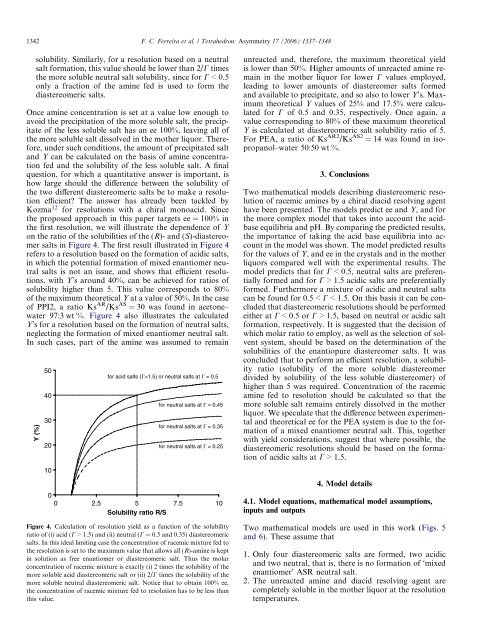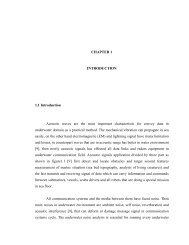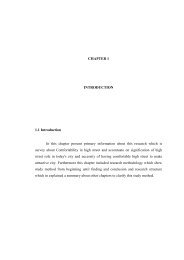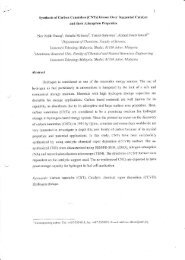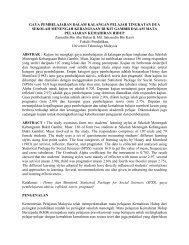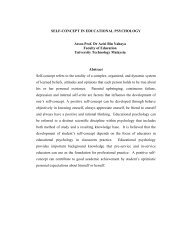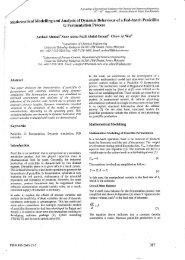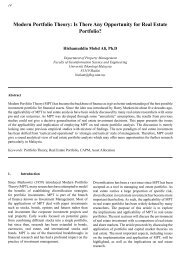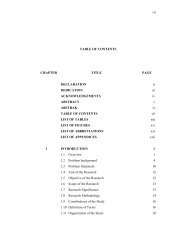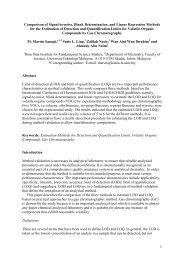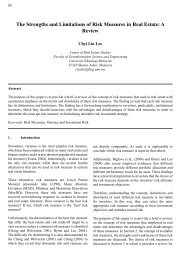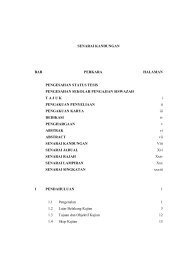Rational approach to the selection of conditions for diastereomeric ...
Rational approach to the selection of conditions for diastereomeric ...
Rational approach to the selection of conditions for diastereomeric ...
You also want an ePaper? Increase the reach of your titles
YUMPU automatically turns print PDFs into web optimized ePapers that Google loves.
1342 F. C. Ferreira et al. / Tetrahedron: Asymmetry 17 (2006) 1337–1348<br />
solubility. Similarly, <strong>for</strong> a resolution based on a neutral<br />
salt <strong>for</strong>mation, this value should be lower than 2/C times<br />
<strong>the</strong> more soluble neutral salt solubility, since <strong>for</strong> C < 0.5<br />
only a fraction <strong>of</strong> <strong>the</strong> amine fed is used <strong>to</strong> <strong>for</strong>m <strong>the</strong><br />
<strong>diastereomeric</strong> salts.<br />
Once amine concentration is set at a value low enough <strong>to</strong><br />
avoid <strong>the</strong> precipitation <strong>of</strong> <strong>the</strong> more soluble salt, <strong>the</strong> precipitate<br />
<strong>of</strong> <strong>the</strong> less soluble salt has an ee 100%, leaving all <strong>of</strong><br />
<strong>the</strong> more soluble salt dissolved in <strong>the</strong> mo<strong>the</strong>r liquor. There<strong>for</strong>e,<br />
under such <strong>conditions</strong>, <strong>the</strong> amount <strong>of</strong> precipitated salt<br />
and Y can be calculated on <strong>the</strong> basis <strong>of</strong> amine concentration<br />
fed and <strong>the</strong> solubility <strong>of</strong> <strong>the</strong> less soluble salt. A final<br />
question, <strong>for</strong> which a quantitative answer is important, is<br />
how large should <strong>the</strong> difference between <strong>the</strong> solubility <strong>of</strong><br />
<strong>the</strong> two different <strong>diastereomeric</strong> salts be <strong>to</strong> make a resolution<br />
efficient? The answer has already been tackled by<br />
Kozma 12 <strong>for</strong> resolutions with a chiral monoacid. Since<br />
<strong>the</strong> proposed <strong>approach</strong> in this paper targets ee = 100% in<br />
<strong>the</strong> first resolution, we will illustrate <strong>the</strong> dependence <strong>of</strong> Y<br />
on <strong>the</strong> ratio <strong>of</strong> <strong>the</strong> solubilities <strong>of</strong> <strong>the</strong> (R)- and (S)-diastereomer<br />
salts in Figure 4. The first result illustrated in Figure 4<br />
refers <strong>to</strong> a resolution based on <strong>the</strong> <strong>for</strong>mation <strong>of</strong> acidic salts,<br />
in which <strong>the</strong> potential <strong>for</strong>mation <strong>of</strong> mixed enantiomer neutral<br />
salts is not an issue, and shows that efficient resolutions,<br />
with Y’s around 40%, can be achieved <strong>for</strong> ratios <strong>of</strong><br />
solubility higher than 5. This value corresponds <strong>to</strong> 80%<br />
<strong>of</strong> <strong>the</strong> maximum <strong>the</strong>oretical Y at a value <strong>of</strong> 50%. In <strong>the</strong> case<br />
<strong>of</strong> PPI2, a ratio Ks AR /Ks AS = 30 was found in ace<strong>to</strong>ne–<br />
water 97:3 wt %. Figure 4 also illustrates <strong>the</strong> calculated<br />
Y’s <strong>for</strong> a resolution based on <strong>the</strong> <strong>for</strong>mation <strong>of</strong> neutral salts,<br />
neglecting <strong>the</strong> <strong>for</strong>mation <strong>of</strong> mixed enantiomer neutral salt.<br />
In such cases, part <strong>of</strong> <strong>the</strong> amine was assumed <strong>to</strong> remain<br />
Y (%)<br />
50<br />
40<br />
30<br />
20<br />
10<br />
0<br />
<strong>for</strong> acid salts (Γ>1.5) or neutral salts at Γ = 0.5<br />
<strong>for</strong> neutral salts at Γ = 0.45<br />
<strong>for</strong> neutral salts at Γ = 0.35<br />
<strong>for</strong> neutral salts at Γ = 0.25<br />
0 2.5 5 7.5 10<br />
Solubility ratio R/S<br />
Figure 4. Calculation <strong>of</strong> resolution yield as a function <strong>of</strong> <strong>the</strong> solubility<br />
ratio <strong>of</strong> (i) acid (C > 1.5) and (ii) neutral (C = 0.5 and 0.35) <strong>diastereomeric</strong><br />
salts. In this ideal limiting case <strong>the</strong> concentration <strong>of</strong> racemic mixture fed <strong>to</strong><br />
<strong>the</strong> resolution is set <strong>to</strong> <strong>the</strong> maximum value that allows all (R)-amine is kept<br />
in solution as free enantiomer or <strong>diastereomeric</strong> salt. Thus <strong>the</strong> molar<br />
concentration <strong>of</strong> racemic mixture is exactly (i) 2 times <strong>the</strong> solubility <strong>of</strong> <strong>the</strong><br />
more soluble acid <strong>diastereomeric</strong> salt or (ii) 2/C times <strong>the</strong> solubility <strong>of</strong> <strong>the</strong><br />
more soluble neutral <strong>diastereomeric</strong> salt. Notice that <strong>to</strong> obtain 100% ee,<br />
<strong>the</strong> concentration <strong>of</strong> racemic mixture fed <strong>to</strong> resolution has <strong>to</strong> be less than<br />
this value.<br />
unreacted and, <strong>the</strong>re<strong>for</strong>e, <strong>the</strong> maximum <strong>the</strong>oretical yield<br />
is lower than 50%. Higher amounts <strong>of</strong> unreacted amine remain<br />
in <strong>the</strong> mo<strong>the</strong>r liquor <strong>for</strong> lower C values employed,<br />
leading <strong>to</strong> lower amounts <strong>of</strong> diastereomer salts <strong>for</strong>med<br />
and available <strong>to</strong> precipitate, and so also <strong>to</strong> lower Y’s. Maximum<br />
<strong>the</strong>oretical Y values <strong>of</strong> 25% and 17.5% were calculated<br />
<strong>for</strong> C <strong>of</strong> 0.5 and 0.35, respectively. Once again, a<br />
value corresponding <strong>to</strong> 80% <strong>of</strong> <strong>the</strong>se maximum <strong>the</strong>oretical<br />
Y is calculated at <strong>diastereomeric</strong> salt solubility ratio <strong>of</strong> 5.<br />
For PEA, a ratio <strong>of</strong> Ks AR2 /Ks AS2 = 14 was found in isopropanol–water<br />
50:50 wt %.<br />
3. Conclusions<br />
Two ma<strong>the</strong>matical models describing <strong>diastereomeric</strong> resolution<br />
<strong>of</strong> racemic amines by a chiral diacid resolving agent<br />
have been presented. The models predict ee and Y, and <strong>for</strong><br />
<strong>the</strong> more complex model that takes in<strong>to</strong> account <strong>the</strong> acidbase<br />
equilibria and pH. By comparing <strong>the</strong> predicted results,<br />
<strong>the</strong> importance <strong>of</strong> taking <strong>the</strong> acid base equilibria in<strong>to</strong> account<br />
in <strong>the</strong> model was shown. The model predicted results<br />
<strong>for</strong> <strong>the</strong> values <strong>of</strong> Y, and ee in <strong>the</strong> crystals and in <strong>the</strong> mo<strong>the</strong>r<br />
liquors compared well with <strong>the</strong> experimental results. The<br />
model predicts that <strong>for</strong> C < 0.5, neutral salts are preferentially<br />
<strong>for</strong>med and <strong>for</strong> C > 1.5 acidic salts are preferentially<br />
<strong>for</strong>med. Fur<strong>the</strong>rmore a mixture <strong>of</strong> acidic and neutral salts<br />
can be found <strong>for</strong> 0.5 < C < 1.5. On this basis it can be concluded<br />
that <strong>diastereomeric</strong> resolutions should be per<strong>for</strong>med<br />
ei<strong>the</strong>r at C < 0.5 or C > 1.5, based on neutral or acidic salt<br />
<strong>for</strong>mation, respectively. It is suggested that <strong>the</strong> decision <strong>of</strong><br />
which molar ratio <strong>to</strong> employ, as well as <strong>the</strong> <strong>selection</strong> <strong>of</strong> solvent<br />
system, should be based on <strong>the</strong> determination <strong>of</strong> <strong>the</strong><br />
solubilities <strong>of</strong> <strong>the</strong> enantiopure diastereomer salts. It was<br />
concluded that <strong>to</strong> per<strong>for</strong>m an efficient resolution, a solubility<br />
ratio (solubility <strong>of</strong> <strong>the</strong> more soluble diastereomer<br />
divided by solubility <strong>of</strong> <strong>the</strong> less soluble diastereomer) <strong>of</strong><br />
higher than 5 was required. Concentration <strong>of</strong> <strong>the</strong> racemic<br />
amine fed <strong>to</strong> resolution should be calculated so that <strong>the</strong><br />
more soluble salt remains entirely dissolved in <strong>the</strong> mo<strong>the</strong>r<br />
liquor. We speculate that <strong>the</strong> difference between experimental<br />
and <strong>the</strong>oretical ee <strong>for</strong> <strong>the</strong> PEA system is due <strong>to</strong> <strong>the</strong> <strong>for</strong>mation<br />
<strong>of</strong> a mixed enantiomer neutral salt. This, <strong>to</strong>ge<strong>the</strong>r<br />
with yield considerations, suggest that where possible, <strong>the</strong><br />
<strong>diastereomeric</strong> resolutions should be based on <strong>the</strong> <strong>for</strong>mation<br />
<strong>of</strong> acidic salts at C > 1.5.<br />
4. Model details<br />
4.1. Model equations, ma<strong>the</strong>matical model assumptions,<br />
inputs and outputs<br />
Two ma<strong>the</strong>matical models are used in this work (Figs. 5<br />
and 6). These assume that<br />
1. Only four <strong>diastereomeric</strong> salts are <strong>for</strong>med, two acidic<br />
and two neutral, that is, <strong>the</strong>re is no <strong>for</strong>mation <strong>of</strong> ‘mixed<br />
enantiomer’ ASR neutral salt.<br />
2. The unreacted amine and diacid resolving agent are<br />
completely soluble in <strong>the</strong> mo<strong>the</strong>r liquor at <strong>the</strong> resolution<br />
temperatures.


